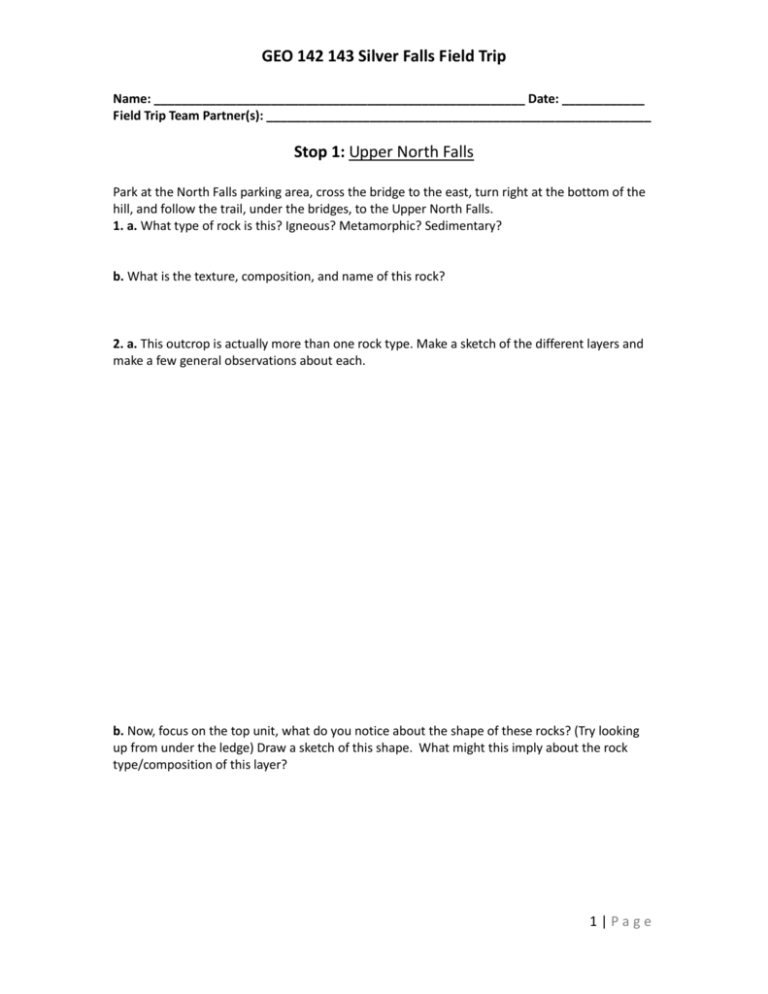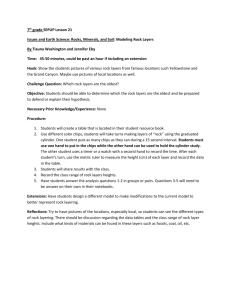GEO_142_143_field_tr..
advertisement

GEO 142 143 Silver Falls Field Trip Name: ______________________________________________________ Date: ____________ Field Trip Team Partner(s): ________________________________________________________ Stop 1: Upper North Falls Park at the North Falls parking area, cross the bridge to the east, turn right at the bottom of the hill, and follow the trail, under the bridges, to the Upper North Falls. 1. a. What type of rock is this? Igneous? Metamorphic? Sedimentary? b. What is the texture, composition, and name of this rock? 2. a. This outcrop is actually more than one rock type. Make a sketch of the different layers and make a few general observations about each. b. Now, focus on the top unit, what do you notice about the shape of these rocks? (Try looking up from under the ledge) Draw a sketch of this shape. What might this imply about the rock type/composition of this layer? 1|Page GEO 142 143 Silver Falls Field Trip c. Focus on the layer directly below the ledge. What is different about this layer? Try to find a spot where you can see small circular objects within the rock. What are these? What might this tell us about what this area looked like when this layer was deposited? 3. a. How many layers can you identify behind the falls? What do you think their composition/rock type is? b. What about the layer of rocks at the river’s edge (i.e. the one you are standing on)? Is this different of the same? Describe it. Why must this layer be a different composition then the layers above? c. Speculate on the rounded/horse-shoe shape of the entire area we are viewing. What caused this? 2|Page GEO 142 143 Silver Falls Field Trip Stop 2: North Falls Hike downstream to the North Falls. Stop at the trail when you have a good look of the falls. 1. a. Observe the falls. What are some of the first things you notice? b. What is creating the ledge that is jutting out and the void of rock below/behind the falls? c. What type of rock makes up the huge boulders at the bottom of the falls? How can you tell? d. Look through the falls to the rock outcrop behind the falls. What do you notice about the layers there? What type of rock might this be and how does it relate to the cause of the falls? 3|Page GEO 142 143 Silver Falls Field Trip 2. Hike behind the falls and determine what types of rock we are dealing with. Make a list of detailed observations about both rocks types we see. Also look for tree casts. Stop # 3: South Falls rim trail and South Falls Loop Drive to the South Falls Day-Use Area Parking Lot. Hike westward towards the South Falls (pass the lodge, and the gift shop). Stop at the South Falls Trailhead and observe the falls from the lookout/rim trail area before descending down the trail to the loop. 1. From the rim or lookout, sketch and number the layers you observe behind the waterfall and describe them. Are they all the same? What distinguishes them? What is the volcanic history and composition of the thicker layers? What do you notice about the shape of the falls area from this viewpoint? 4|Page GEO 142 143 Silver Falls Field Trip 2. Hike behind the falls. This is the best spot to check out the “other layer” and describe it in more detail. a. Find a place where the “other layer” outcrops (check out the whole outcrop before deciding on a spot) and sketch and describe it in detail. b. Why does the rock above the “other layer” appear rounded instead of columnar where the two come into contact? What does this imply about the area when the upper rock was erupted? c. What are the very large holes in the upper rock from? Find one you can safely climb into. Use a flashlight and see if you can find some impressions or clues as to what formed it. 5|Page GEO 142 143 Silver Falls Field Trip Final Part: Follow Up During lunch or the trip home speculate on what North and South Falls would have looked like when it first formed and what it might look like a million years from now. Use words or sketches to describe this. 6|Page







